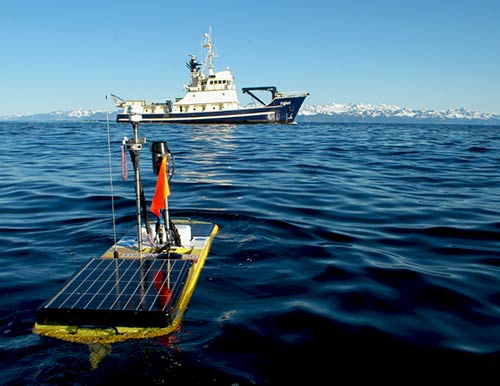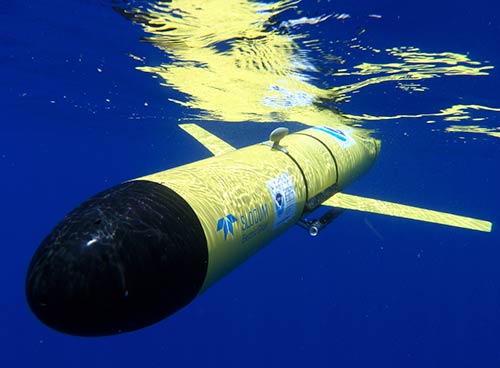|
Fish Factor Revolutionary Technology: Unmanned GlidersBy LAINE WELCHJuly 11, 2014
“It’s been hugely successful. We’ve flown these things all over inside and outside of Prince William Sound, we’ve had great control over them, we’ve been able to move them to exactly where we want them to be. They are making thousands of measurements all over,” said Jeremy Mathis, director of the Ocean Environment Research Division at the Pacific Marine Environmental Lab in Seattle. Mathis also is an affiliate faculty member at the University of Alaska/Fairbanks and oversees studies at Newport, Oregon.
Scientists and crew aboard Alaska Maritime National Wildlife Refuge's M/V Tiglax are among NOAA's partners in research in Prince William Sound on ocean acidification. (Wiley Evans, NOAA's Cooperative Institute for Alaska Research at the University of Alaska Fairbanks)
Ocean acidification is a global phenomenon being driven by increased, human produced levels of carbon dioxide in the atmosphere from the burning of fossil fuels. It is changing the chemistry of the entire ocean at a slow, methodical pace. “So now we have this anthropogenic (manmade) process combining with natural process, and it makes some regions more vulnerable to the impacts of ocean acidification than others. And Prince William Sound is very high up on that list because of the processes that go on inside of it.” Since May two Carbon Wave Gliders resembling yellow surfboards have been propelled around the Sound by wave motions to test surface water conditions. The gliders are controlled remotely back in the Seattle lab with an iPad. Another so called Slocum Glider, also controlled remotely, resembles a yellow torpedo and makes dives down to 600 feet and then resurfaces.
The Slocum glider tracks ocean data down to 200 meters to help scientists understand the downstream effects of melting glaciers and how this may intensify ocean acidification. (Ben Allsup, Teledyne Webb Research)
Prior to using the gliders, researchers were limited to contracting with boats and crews and taking only about four water samples each year. “This is a revolution. I’ve been working on ocean acidification in Prince William Sound for six years and ship time is so expensive, that’s all we could afford to do. That has severely limited our ability to understand what’s going on because we don’t have the opportunity to collect more than a few data points every year. These gliders are a fraction of the cost and we can leave them out for five months,” he added. “It will change the way we collect data, the way we can understand ecosystem environmental processes. The ultimate goal is to make sure we understand what is going on with the fisheries and the biology and communicate that back to the fishing communities and stakeholders in Alaska.” The gliders were tested once off the West Coast, but the PWS project is the first time they’ve really been let loose, Mathis said. “To hedge our bets, we have people we can call with fast boats in Valdez, Seward and Whittier if a glider gets run over by a tanker, or it dies for some reason. So we have this human insurance policy if we do have trouble and they can get to them for us,” he said. The data is already showing some preliminary results. “We are seeing that the glacial plume inside and moving out into the Gulf of Alaska is far more extensive than we thought it was going to be. One of our conclusions is that the glaciers are having quite an extensive impact on the water chemistry of Prince William Sound,” Mathis said. The unmanned gliders will soon be deployed throughout the entire Gulf, the Bering Sea and the Arctic Ocean. Creepy soundtracks of noises made by predators had mud crabs running for shelter and proved, for the first time, that the animals can hear. Marine acoustic experts at Boston’s Northeastern University made the discovery in lab tests on 200 mud crabs during a two year study. When they piped in certain noises, the crabs didn’t dare venture out to eat juicy clams placed in their tanks and their skittishness lasted for several hours. The scientists said the crabs hear through a small sac at the base of their antennae called a statocyst. It contains thousands of sensory hairs important for the animal’s balance but also, the study found, for responding to sounds. Might it be the same for Alaska crab? “That’s unknown. I’m not aware of any studies that have gone into that level of detail on the sensory organs or abilities of any of the commercial crab species in Alaska,” said Bob Foy, director of NOAA Fisheries top crab lab at Kodiak. “I would not be surprised if it was the same,” he added. “Sound is just a pressure wave, so I’m not surprised that the crab can hear the sound. The interesting fact is how they are reacting to a predator or to another organism being there, and being able to measure that stress that the animal is undergoing at the same time.” Other studies showed that ship sounds affected foraging behavior of shore crabs. Foy said all of the findings can be important for crab scientists and managers on a couple of fronts. “Just knowing that the animals have that additional sensory capability is huge for us to understand how they are interacting with their environment. Crab communication is very important,” he explained. “We are trying to understand the behavior of the crab, such as how the males and females find each other. Crabs don’t broadcast spawn like a fish does; they have to find each other in a very large ocean. So knowing more about their behaviors at that level would be critical for understanding how these animals are moving throughout their environment. Another thing is how the impacts of sonar from oil drilling or ship noises and other kinds of sensory environmental impacts may or may not affect these animals. Knowing that they do have this (hearing) sensitivity helps us think about how we might test for these things.” Foy called the crab hearing studies “fascinating” and hopes they continue. Foy says he hopes the crab hearing studies continue. “If you had asked me if crabs can hear prior to this, I probably would have said they probably have a way of detecting sound,” he said. “But seeing how they are detecting it and then responding to noises and other predators is very intriguing in terms of how we might be able to use this in the future. The various business and landing taxes on fish usually equal 3–5 percent of the dockside values, and are shared 50/50 between the local areas where the fish is delivered and state coffers, to be distributed at the whim of the Alaska legislature. The industry also pays other taxes and fees which cover management, marketing, hatcheries and other costs. Wink said Alaska’s seafood industry accounts for the vast majority of hatchery funding, allowing both sport and commercial fishermen the benefit of more salmon. This year marks the 24th year for this weekly column that focuses on Alaska’s seafood industry. It began in 1991 in the Anchorage Daily News, and now appears in over 20 newspapers and web sites. A daily spin off – Fish Radio – airs weekdays on 30 radio stations in Alaska. My goal is to make all people aware of the economic, social and cultural importance of Alaska’s fishing industry to our state, the nation and the world. Laine Welch ©2014 www.alaskafishradio.com SitNews ©2014 Stories In The News Ketchikan, Alaska
|
||


